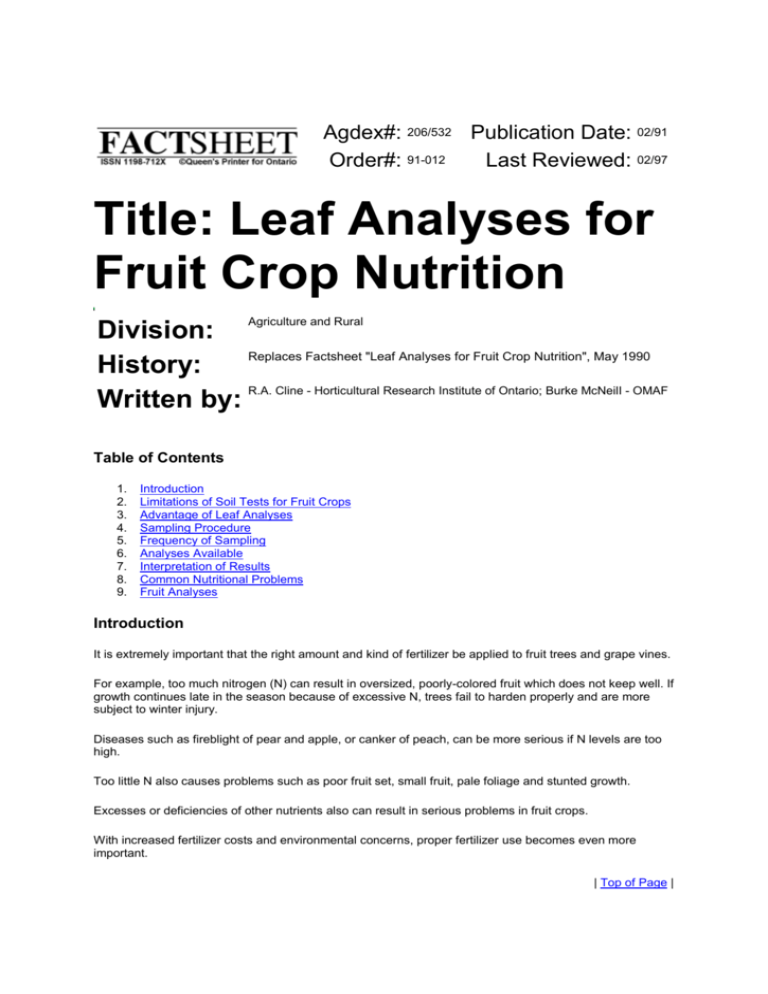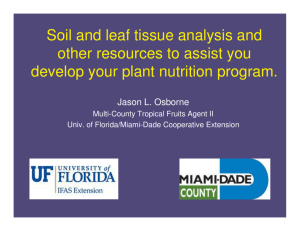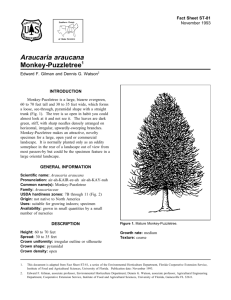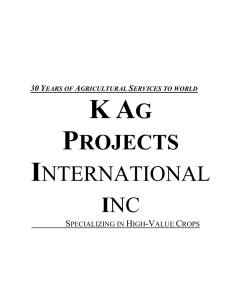Leaf analysis guidelines
advertisement

Agdex#: 206/532 Publication Date: 02/91 Order#: 91-012 Last Reviewed: 02/97 Title: Leaf Analyses for Fruit Crop Nutrition Agriculture and Rural Division: Replaces Factsheet "Leaf Analyses for Fruit Crop Nutrition", May 1990 History: R.A. Cline - Horticultural Research Institute of Ontario; Burke McNeilI - OMAF Written by: Table of Contents 1. 2. 3. 4. 5. 6. 7. 8. 9. Introduction Limitations of Soil Tests for Fruit Crops Advantage of Leaf Analyses Sampling Procedure Frequency of Sampling Analyses Available Interpretation of Results Common Nutritional Problems Fruit Analyses Introduction It is extremely important that the right amount and kind of fertilizer be applied to fruit trees and grape vines. For example, too much nitrogen (N) can result in oversized, poorly-colored fruit which does not keep well. If growth continues late in the season because of excessive N, trees fail to harden properly and are more subject to winter injury. Diseases such as fireblight of pear and apple, or canker of peach, can be more serious if N levels are too high. Too little N also causes problems such as poor fruit set, small fruit, pale foliage and stunted growth. Excesses or deficiencies of other nutrients also can result in serious problems in fruit crops. With increased fertilizer costs and environmental concerns, proper fertilizer use becomes even more important. | Top of Page | Limitations of Soil Tests for Perennial Fruit Crops Soil tests have limited value for deeply rooted fruit trees and grapes because of the difficulty of obtaining representative soil samples over a wide and varying rooting zone. N is frequently the most critical nutrient and there is no satisfactory soil test for N. Also the soil test for potassium (K) does not always indicate the K available for growth of trees or vines. However, soil tests are useful for perennial fruit crops to indicate the soil pH or acidity and the need for lime. Low pH can lead to poor growth of trees or grapes and disorders such as manganese (Mn) toxicity of peaches or Red Delicious apples (measles). The best time to apply lime is before planting the orchard when it can be worked thoroughly into the soil. In established orchards, if the soil is extremely acid (pH below 5.0) lime should be applied and directed to the herbicide strip or incorporated in cultivated orchards. It is more difficult and not practical to lower the pH of alkaline soils. Soil pH should be checked every 2 to 3 years. | Top of Page | Advantages of Leaf Analyses The best method of determining the kind and amount of fertilizer to apply to fruit trees is by leaf analyses. It effectively measures macro and micronutrients and indicates the need for changes in fertilizer programs. Leaf analyses integrates all the factors that might influence nutrient availability and uptake. It shows the balance between nutrients. For example magnesium (Mg) deficiency may be the result of a lack of Mg in the soil or from excessive K levels or both of these conditions. Leaf analyses indicates the balance between K and Mg. It also shows hidden or incipient deficiencies. Adding N, for example, when K is low may result in K deficiency because the increased growth requires more K. The Ontario Leaf Analysis Service for fruit, initiated in 1958, was one of the first to be introduced in North America. An analytical service is now available from accredited private laboratories for apple, peach, pear, plum, cherry, grape, strawberry and blueberry. Growers of these crops have an effective method of predicting fertilizer requirements and of measuring responses to their fertilizer and cultural programs. | Top of Page | Sampling Leaf samples must be taken at the proper time and in the proper way for the analyses to be meaningful and representative of the orchard. Nutrient levels within the plant are continually changing. N, phosphorus (P) and K levels normally decrease, while calcium (Ca) and Mg increase as the season progresses. A time for sampling must be selected when leaf nutrient levels are relatively stable and best reflect the nutrient needs of the tree or vine. In Ontario, leaf samples are taken from fruit trees the last two weeks of July. Leaf petioles are taken from grape vines in early September. Leaf blades from fruiting strawberries should be taken in June and non-fruiting plantings in early August. Blueberry leaves should be taken in early August. Leaves from fruit trees are selected midway on the current season 5 growth (Figure 1) at shoulder height. Approximately 10 leaves from 10 representative trees provide sufficient material. If the orchard is variable, take fewer leaves from more trees to give a total of 100 leaves per sample. Take fully expanded leaves from shoots on all sides of the tree. Avoid damaged leaves (insect, disease, mechanical). Do not take spur leaves, more than two leaves per shoot or leaves from outside rows. Abnormal-appearing trees should be avoided. If variable areas are large enough to be fertilized differently, then sample them separately. Most cultivars (varieties) differ in their composition and should be sampled separately. If several cultivars are in a block, one cultivar may be used to represent the orchard. Samples from trees on different apple rootstocks should also be kept separate. Figure 1. Mature mid shoot leaves selected for analyses for tree fruits. Figure 2. Location of leaf petioles to be used for grapes. Grape leaf petioles (stems) are selected from mature leaves of bearing canes in September. Leaves opposite bunches are preferred (Figure 2). Young or senescent leaves should be avoided. Only the petioles are used in analyses. The leaf blade should be separated immediately and discarded. Up to 200 petioles are needed for some cultivars. In contrast leaf blades are used for strawberries. Discard the petioles. Select fully expanded recently matured leaves. At least 50 representative blades are needed per sample. Approximately 150 fully expanded mature leaves including petioles are used for blueberry. Samples should be placed in paper bags and clearly identified. They should be kept dry and free of dust. Fruit tree leaf samples should be taken and delivered by August 1, grape petioles by September 20, strawberry leaf blades by July 1 or August 20 for fruiting and non-fruiting plantings respectively, and blueberry samples by August 20. If you have questions about sampling procedures or need submission forms, contact your local Horticultural Crop Advisor or accredited laboratory. | Top of Page | Frequency of Sampling Many growers sample the same cultivar in the same block each year to ensure that nutrients are maintained at satisfactory levels. Others prefer to rotate their samples between cultivars and blocks if there are no problems. If nutrients are excessive, deficient or out of balance, samples should be taken each year until levels are normal. If a major change in fertilizer or soil management program is made, samples should be taken each year until nutrient levels have stabilized. Then monitoring of nutrient levels by leaf analyses every two or three years should be sufficient. | Top of Page | Analyses All samples are analyzed for N, P, K, Ca, Mg. If boron (B), zinc (Zn), manganese (MN) or iron (Fe) deficiencies or excesses are suspected, these nutrients can also be determined. A list of laboratories presently accredited for leaf analysis and fees for service is available from your OMAF Field Office. Send the samples with clearly completed submission forms to the Laboratory of your choice. Include payment as samples will not be processed without fees. | Top of Page | Interpretation Optimum ranges for nutrient concentrations have been established for leaves or petioles of various fruit types and cultivars (Table 1). The concentration of nutrients found in your samples should be compared to these ranges to determine the status of nutrients in your samples. Concentrations above the optimum range are considered excessive and the rate of fertilizer containing that nutrient should be reduced or eliminated. Conversely concentrations below the optimum range are considered deficient and the rate of fertilizer containing that nutrient should be increased. Nutrient levels within the optimum range are considered adequate but fertilizer rates may be adjusted up or down depending on whether the concentration is near the bottom or top of the optimum range. The optimum range values vary slightly depending on growing season cultivar, rootstock. tree age, area of the province, etc. Optimum nutrient ranges for different fruit crops are given in Table 1. Table 1. Optimum Ranges of Nutrient Concentrations N* Apple** Delicious Crispin Empire Russet Spy McIntosh & Other Varieties Pear Peach Cherry Plum Grape petioles P K Ca % dry weight Mg MN Fe Zn B ppm 2.2-2.7 .15-.40 1.4-2.2 .8-1.5 .25-40 20-200 25-200 15-100 20-60 2.1-2.6 .15-.40 1.3-2.1 .7-1.5 .25-.40 20-200 25-200 15-100 20-60 2.0-2.4 .15-.40 1.2-2.0 .8-1.5 .25-.40 20-200 25-200 15-100 20-60 2.0-2.6 3.4-4.1 2.2-3.0 2.4-3.2 .15-.40 .15-.40 .15-.40 .15-.40 1.2-2.0 2.3-3.5 1.3-2.5 1.5-3.0 1.0-2.0 1.0-2.5 1.0-2.5 1.0-2.5 .25-.50 .3 -.60 .35-.65 .35-.65 20-200 20-200 20-200 20-200 25-200 25-200 25-200 25-200 15-100 15-100 15-100 15-100 20-60 20-60 20-60 20-60 .7-1.3 .15-.40 .8-2.5 1.0-3.0 .5-1.5 20-200 15-100 15-100 20-60 Strawberry Leaf blades Blueberry 2.0-3.0 .20-.50 1.5-2.5 .5-1.5 .25-.50 20-200 25-200 15-100 20-60 1.7-2.3 .15-.40 .3- .8 .12- .3 150-500 30-100 10-100 15-50 .36- .7 *Optimum N ranges will be approximately .2% higher if the planting is not yet bearing. **Increase optimum N ranges by .2% for all apple cultivars on size controlling rootstocks M9 and M26. Many factors must be considered when interpreting these ratings in terms of changes to a fertilizer program. For example, N levels will be higher because of severe pruning regardless of fertilizer program. This should be considered if the orchard was or is planned to be heavily pruned. Moisture supply before sampling can also effect nutrient levels. Dry conditions will usually result in lower N and K and higher Mg in leaf tissue. Spray application of Mg, micronutrients or pesticides containing nutrients, will raise the level of these nutrients found in leaf tissue. Information concerning soil texture, drainage and cation fixing capacity is important. System of soil management, past fertilizer program, growth, foliage color, crop history, fruit quality and storage life are all important and should be considered when interpreting leaf analyses data in terms of changes to fertilizer programs. The balance between nutrients should be carefully examined. For example, increasing K rate when Mg is low may cause Mg deficiency. An increase in N when K is low may result in K deficiency. As an example of how leaf analyses data might be interpreted, a Delicious apple leaf sample taken the last 2 weeks of July tests 2.30% N. This is at the low end of the optimum range and suggests a need for slightly more fertilizer N. If the trees had been heavily pruned the previous spring a greater increase in fertilizer N might be applied since pruning would have increased leaf N concentrations. On the other hand, if the trees are to be pruned heavily next spring, the same rate of fertilizer N might be applied this year since growth and N uptake will be stimulated by the pruning. If the trees are on M26 or M9 rootstock, an even greater increase in N rate should be applied since the leaf N is no longer in the optimum range. If the leaf K is 1.4% an increased rate of K fertilizer is needed since this is the bottom of the optimum range and an increase in N fertilizer rate will increase the need for K. The increased K rate may increase the need for Mg if the Mg concentration is below .25%. For fertilizer suggestions refer to OMAF Publication 360, Fruit Production Recommendations. | Top of Page | Common Nutritional Problems N control is the most common and serious nutritional problem in Ontario orchards and vineyards. Excessive levels of N occur more frequently than deficient levels. K deficiency and excess are also frequently encountered. Grapes, for example, often show K deficiency as the crop matures, even though the clay loam soils on which they are grown test high in K. This is more serious in dry years or with heavy crops. Excessive K can lead to Mg deficiency. Low Mg levels, particularly in vineyards and apple orchards are becoming more common. Zn, MN and B deficiencies have been found in Ontario orchards. Although not widespread, these deficiencies do cause crop and/or quality loss in isolated orchards. All of these disorders can be most readily identified by leaf analysis. In many cases, growers have found that the cost for each leaf sample has been returned many times over in reduced fertilizer costs and/or in better crops of higher quality fruit. | Top of Page | Fruit Analyses Ca deficiency, resulting in fruit disorders such as bitterpit of apple is common in Ontario even though soils are well supplied with Ca and there may be adequate levels in the leaves. Leaf analyses does not provide a good indication of the Ca status of the fruit. Fruit analyses is a much better indicator. Research has established levels of Ca in various apple cultivars needed to avoid Ca related fruit disorders. Fruit analyses may be used to indicate the long-term storageability of apples. Bunch stem breakdown of certain grape cultivars and gummosis of Italian prune plum have also been related to low levels of Ca in the fruit and avoided by foliar application of Ca. Fruit analyses may be used in Ontario to manage some of these problems. | Top of Page | For more information: Toll Free: 1-877-424-1300 Local: (519) 826-4047 Email: ag.info@omaf.gov.on.ca








